This post is a short, personal record of London’s wild parakeets, seen from a fourth-floor window in West London, from winter into spring.
It can be easy to miss what is just outside the window. Cities can draw our focus inwards, from building to building, room to room, with the outside often blending into the built environment.
I have always seen and heard the parakeets around my apartment block. However, there is something about city life that often feels separate from the natural world. For example, in the city, people move quickly between tasks, most of their days are spent indoors, and therefore, it is easy to forget that life outside the human sphere continues to unfold. Yet, there they were, the bright green parakeets, active in the trees in front of my windows, part of the everyday view.
I had been photographing those birds for years, but during the COVID lockdowns, I started to notice them more. With fewer cars, trains and planes, the city was much quieter. Sounds like foxes barking and screaming, birds chirping and parakeets chattering stood out more. With the usual city background noise much diminished, it was easier to focus on the wildlife around me.
Native to parts of Africa and South Asia, the parakeets might seem unlikely residents of London. Yet they navigate its trees with ease, as though they had always belonged here. Over time, they have become part of the city’s familiar backdrop, as ordinary as routemaster buses and buildings. Their presence, both noticeable and at the same time unassuming, seems to echo something about London itself: a place where arrival from elsewhere often marks the beginning of belonging. Which leads, of course, to the question many people ask when they first see them: how did they get here in the first place?
Theories about how the parakeets arrived in London are plentiful, each holding a place in the city’s folklore. One popular tale, and my favourite urban myth on the subject, suggests they escaped from Shepperton Studios during the filming of The African Queen in 1951. Another claims that Jimi Hendrix released a pair on Carnaby Street, giving the story a kind of 1960s Noah’s Ark moment. There are also accounts of birds fleeing from damaged aviaries during the Great Storm of 1987, one which caused widespread destruction across southern England, the Channel and northern France. Or perhaps they escaped from a cargo shipment mishap at Heathrow Airport? None of these stories can be confirmed, of course. The most likely explanation, though far less colourful, is that the current colonies are the result of a slow and steady accumulation of pet parakeets that either escaped or were deliberately released over the decades.
Three parakeets balance on the bare winter twigs, a shock of colour against the greyness of a foggy morning beyond my fourth-floor window.
In winter, when the poplars are reduced to skeletal frameworks, the parakeets seem almost improbable. From the usual street-level view, birds appear as fleeting shapes overhead, distant and detached. However, the physical closeness of a fourth-floor window allows the photographs to capture them at eye level. Their green colour is no longer a form of camouflage, as it would be in the lush greens of a tropical rainforest; instead, it asserts itself vividly against the dullness of London’s winter.
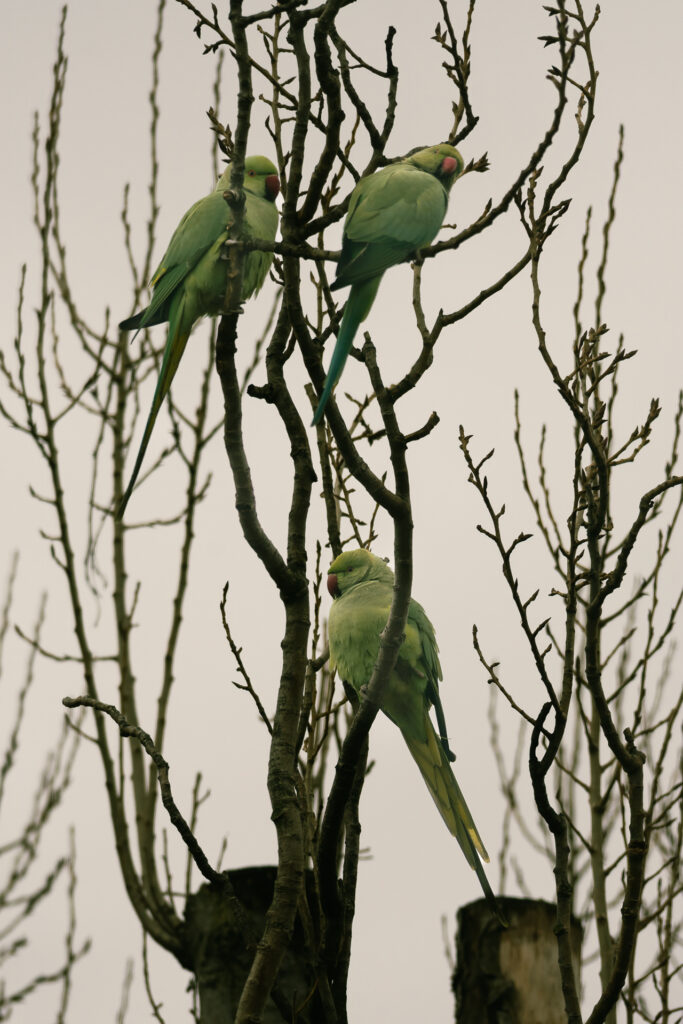
Bathed in the orange tones of sunset, a parakeet turns its head towards my window, as if teasing, “Catch me if you can”.
One afternoon, as the sun began to set, a single parakeet perched in the poplars and turned to face my window.
In London, even the idea of “wildlife” is complicated. The black poplars outside my window, which the parakeets seem to like, were planted. Much of what appears natural in the city is in fact designed, managed and maintained. It is an urban ecology, shaped by human decisions. Still, the birds are here, adapting as they go, making space where space is found.
The presence of non-domestic animals in the city highlights a tension between nature and the built environment. This may be a false divide, however. We often see ourselves as separate from nature, yet, despite the complexity of our cities, we are still biological creatures, subject to the same patterns of life as any other species. The pandemic made this clear, if it was ever in doubt.
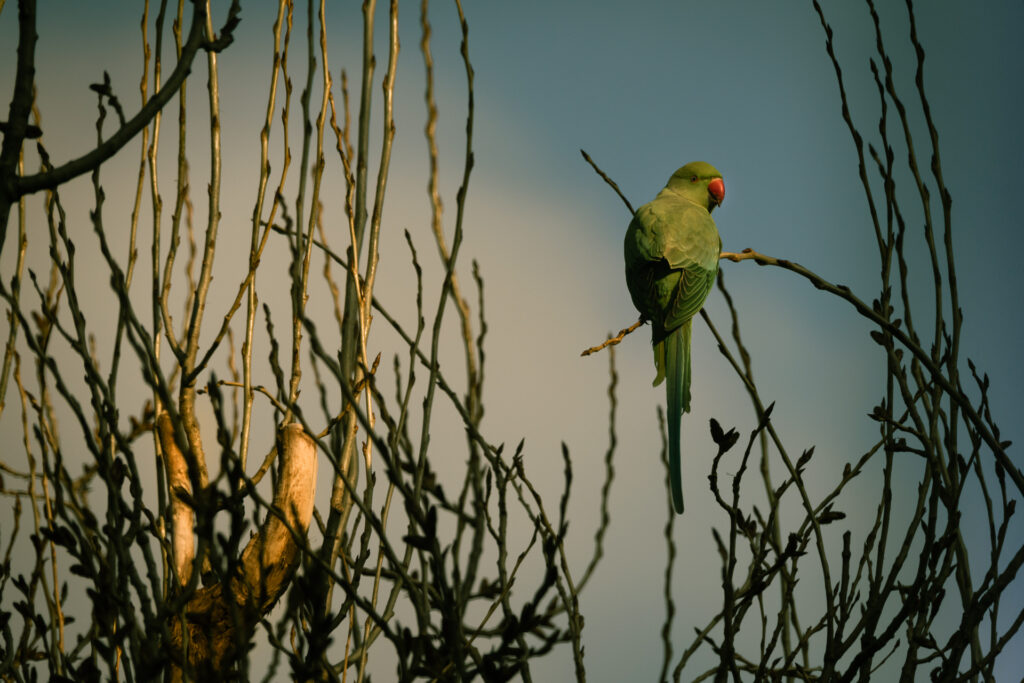
Two parakeets on the trunk of a poplar, framed by the remaining leaves at the beginning of winter, with the blurred greyness of the paved car park below.
From above, the city takes on new shapes: rows of parked cars, scattered trees, fenced gardens, and tarmac areas for vehicles. The parakeets move through it all with the same ease they would a forest. Their ability to adapt to urban spaces and find places to nest is part of why they have thrived.
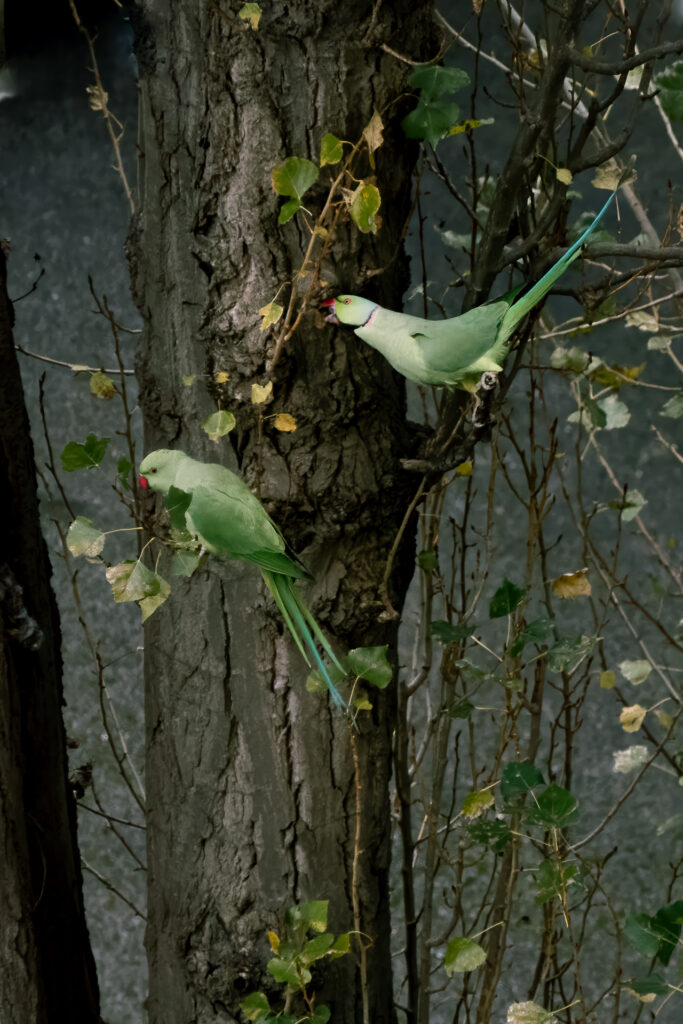
Interrupting the preen for a moment, the parakeet unfurls its feathers.
Watching the parakeets from the fourth floor reveals the rhythm of their days: preening, calling, feeding, and dozing. These are simple patterns of animal life, unfolding within the framework of the city. They live as they would, whether seen or unseen.
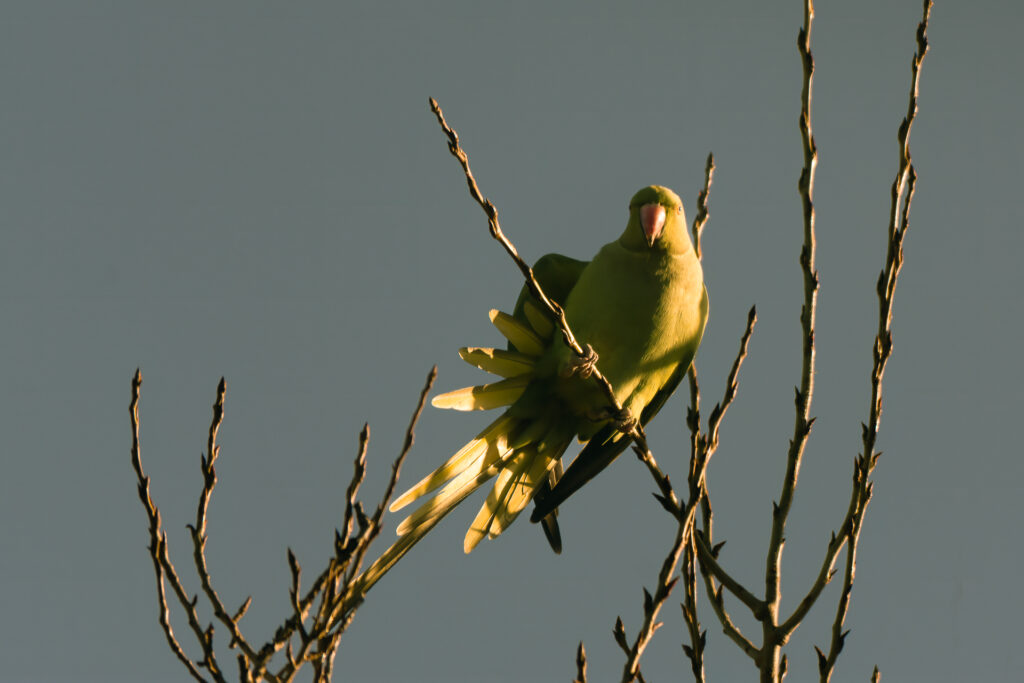
Seen from above, high over the car park, the parakeet, poised among the twigs of the poplar.
The branches above and the concrete of the car park below. The natural and the urban overlap.
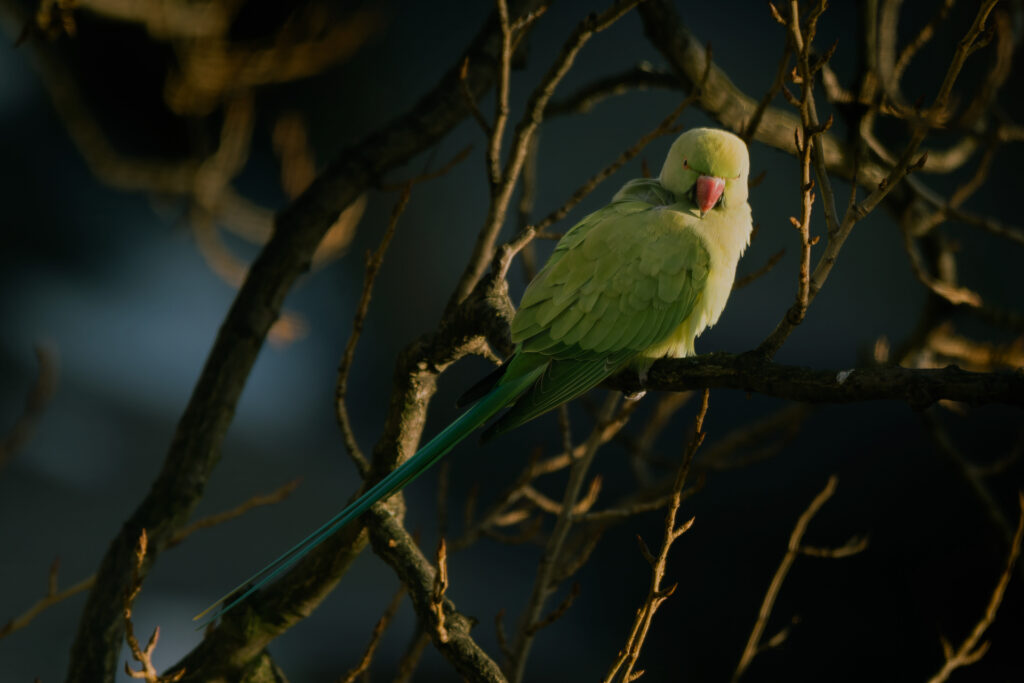
About the Photographs
The inspiration for the colour grade of the photographs came from a particular version of events that I am especially drawn to, perhaps because it involves film and filming. It is the urban myth I have already mentioned earlier in the article, which tells of parakeets escaping during the production of The African Queen, the 1951 film directed by John Huston and starring Humphrey Bogart and Katharine Hepburn. With the film in mind, I developed a colour grade that echoed Jack Cardiff’s approach to colour in this Technicolor production, which featured earthy tones, dark greens, and a strong contrast between light and very deep shadows. The photographs were taken using telephoto zoom lenses, mostly set to their longest focal length to fill the frame. The trees stand about ten metres from my windows, but the birds are small, and such a distance required magnification to capture their detail.
Share this post:
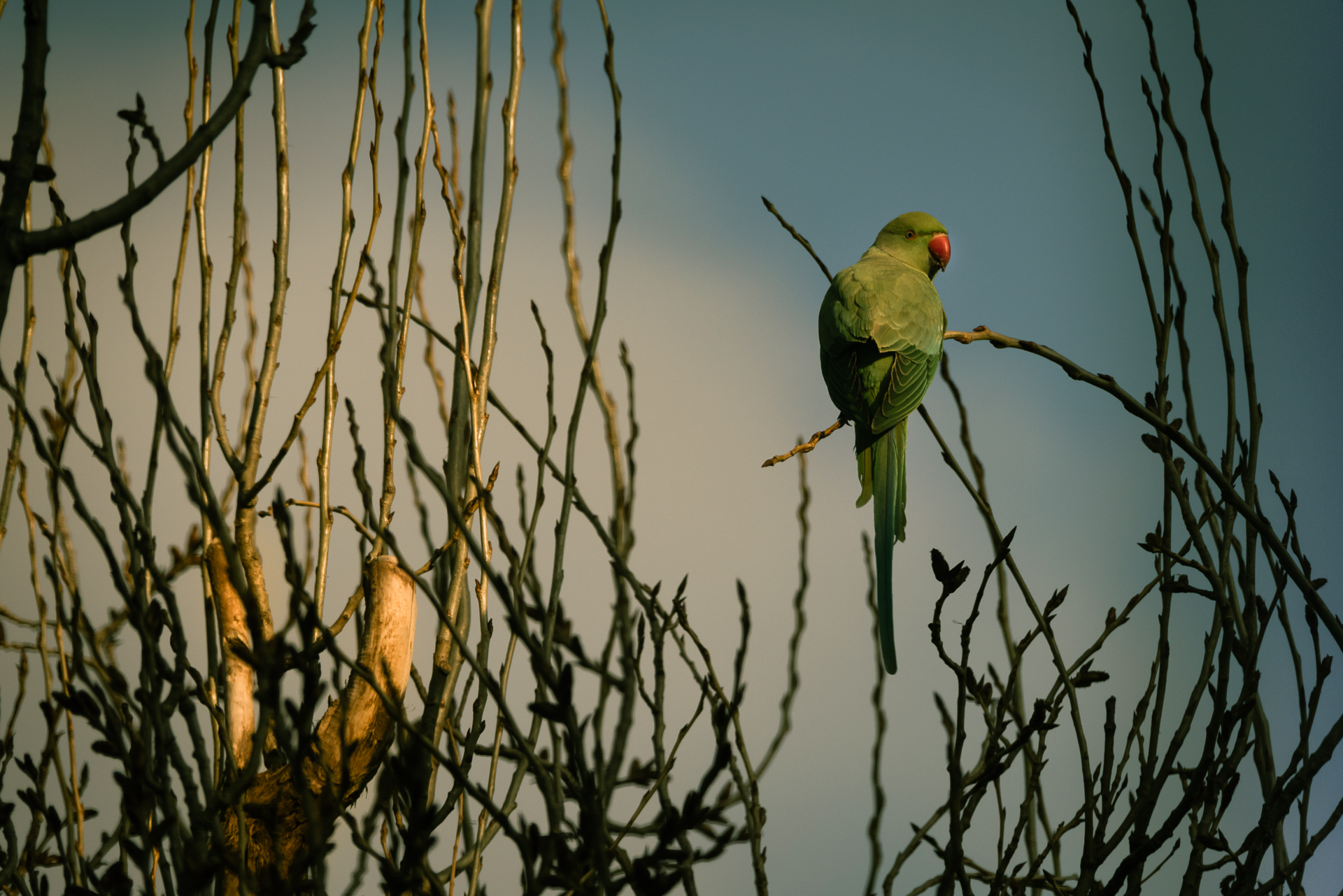



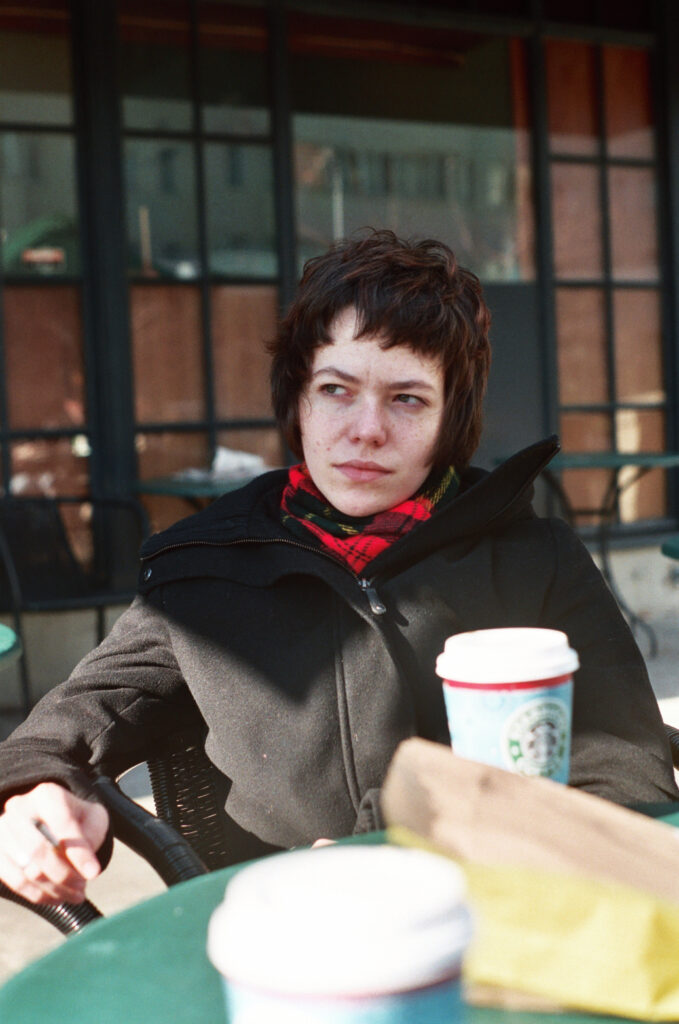




Comments
Bob Janes on Parakeets Playing it Cool in the Cold
Comment posted: 27/05/2025
Lovely pictures - good spots!
Comment posted: 27/05/2025
Comment posted: 27/05/2025
Comment posted: 27/05/2025
Don Ball on Parakeets Playing it Cool in the Cold
Comment posted: 27/05/2025
Comment posted: 27/05/2025
Christopher Collins on Parakeets Playing it Cool in the Cold
Comment posted: 27/05/2025
Well done, a great urban article.
Thank you.
Comment posted: 27/05/2025
Ibraar Hussain on Parakeets Playing it Cool in the Cold
Comment posted: 27/05/2025
I know a lot of people who dislike them but I find them to be beautiful
I too first noticed them many years ago around Hounslow and Richmond in West / South West London
Comment posted: 27/05/2025
Keith Drysdale on Parakeets Playing it Cool in the Cold
Comment posted: 28/05/2025
Comment posted: 28/05/2025
Aniello Del Sorbo on Parakeets Playing it Cool in the Cold
Comment posted: 29/05/2025
also from West London where they seem to be more common than the rest of London (albeit quickly spreading all over)
shame I can't share a couple of pics on here
Comment posted: 29/05/2025
Comment posted: 29/05/2025